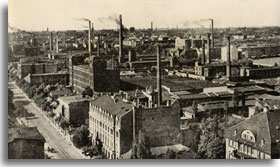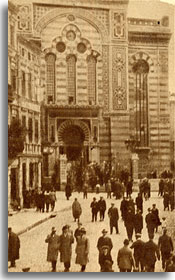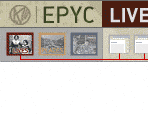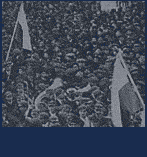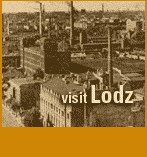

History and Settlement
Grand palaces amidst dirty brick facades, crowded slums bisected by wide boulevards, smokestacks towering above cottages, a broad-shouldered industrial proletariat amongst a handful of millionaire capitalists Lodz was a city of great extremes: "An ocean of miseries and sorrows beneath a mountain of gold and opulence," as a former resident described the city. Lodz was Poland's industrial capital, nicknamed "the Polish Manchester," and it stood out in a country of quaint medieval towns and rural villages.
Dating from the 14th century, Lodz remained a small village for centuries and, therefore lacks the feudal history of most other Polish cities. Its most significant chapter began after 1820, when the newly formed, Russian-controlled Congress Poland decided to transform this sleepy village into an international center for textiles production and other industry. The Czarist government invited German weavers and textile experts to settle in Lodz and to create this new industry. As a result of the numbers of Jews following on the heels of these German settlers, the population of Lodz greatly increased and a new city grew seemingly overnight. The population grew from a few hundred people before 1820, to 500,000 in 1913. By 1939, Lodz's population had increased to 700,000; one third of which was Jewish.
As Lodz became a major beacon for Jewish (and non-Jewish) workers across Europe, old hatreds and restrictions once again followed: Jews initially were confined to a small quarter near the old market square known as "Altshtot," (the old city). Because of the limits on settling in Lodz-proper, most Jews resided in the sister town of Baluty (long ago swallowed by Lodz's expansion), a working-class Jewish district encompassing factories, weavers, craftsmen, peddlers, as well as a few Jewish industrialists. Baluty, never really an affluent area, began a downward spiral during the interwar period (1919-1939). General unemployment after World War I, combined with mounting anti-Semitism, resulted in a largely disenfranchised Jewish population and terrible slum conditions.
Written accounts of both the industrial prosperity and the squalor in Lodz are legion; observers in the early 20th century were quick to note the disrepair of the city's fairly new buildings, the drunks, prostitutes, and generally unhealthful hygienic conditions. The poverty of the people was compounded by a landscape blighted by industrial pollution, with chemical waste pouring into the rivers, toxic drinking water, and foul-smelling sewage.






